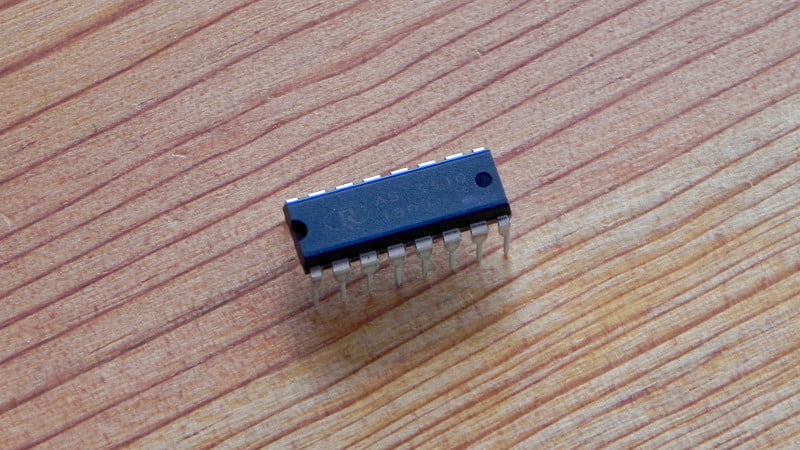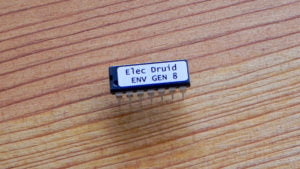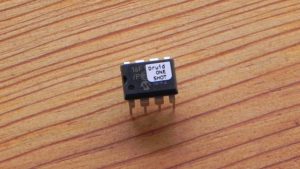Description
The AS3310 is a high performance voltage-controlled analog ADSR envelope generator that is pin-for-pin compatible with the CEM3310.
Attack, Decay and Release times are exponentially voltage controllable over a wide range, and the Sustain level is linearly voltage controllable from 0 to 100% of the peak voltage Vp. All four control inputs are isolated from the rest of the circuitry so that the control pins of tracking units may be simply tied together.
The chip features a large time control range of 50,000:1 minimum with accurate exponential time control, a true RC envelope shape, and exceptionally low control feedthrough (90µV max). It has independent Gate and Trigger inputs, and provides good repeatability between units for polyphonic systems.
Download AS3310 voltage-controlled envelope generator datasheet
These are brand new chips fresh from the Alfa Rpar semiconductor factory in Riga, Latvia.




Robin LeBon –
The attack curve goes up to 5.4V, then decays to the sustain voltage, even if it is 5V. If attack and decay are too short, it generates an audible click in the VCA. The original CEM3310 does not show this behavior. Certainly a design bug.
Tom Wiltshire –
That’s very interesting, Robin. I haven’t come across that. I’ll investigate.
Dave Francis –
Hi Tom, do you have a pinout / datasheet for this chip ? Cheers.
Tom Wiltshire –
Here’s a link:
http://www.alfarzpp.lv/eng/sc/AS3310.pdf
Ron –
I have a prophet 5 with 3 of these in place in the filter envelope section. The voices with these are brighter than the two original Curtis chips. I suspect they perform slightly differently? I’m going to have to order more replacements to replace all the Curtis chips since the synth doesn’t sound uniform and its quite aggravating. Calibrating makes no difference. Swapping them around, the brightness issue follows so I know its not the synth.
Tom Wiltshire –
That’s an interesting finding, thanks Ron. Is it the peak of the attack that is brighter, or the sustain level?
The amazing thing for me is that in 2018 we can now replace *all* the filter envelope generators in Prophet 5 with brand new chips for less than one 35-year-old chip would have cost us only a few years ago. A Prophet with three missing or dead envelopes would have been a very expensive repair, assuming you could even *find* enough chips.
Ron –
Hi Tom (looks like I can’t reply for some reason). It is the overall sustain level. I noticed the poly mod section has a few new replacements as well and it doesn’t sustain at the same pitch as the other voices either. I totally agree with you it is amazing that there are reproduction chips. Not sure how long they will be made for, so I plan at some point to by enough to populate the entire synth so I have coverage in the future. I’m more disappointing in the tech I had restore this, and gave it back in this condition. (it was DOA, I had to fix it myself, now I’m learning the other “nuances” lol). I’ll let you know when I replace the remaining envelope generators with the new clones. I’m sure it will work fine then.
My synth actually has one CEM 3340 rev g. I was going to hunt down an original as I am generally very anal about these things, and have extremely sensitive ears. I must say they did an excellent job, no distinguishable difference whatsoever.
Rob Keeble –
The Digisound implementation of the CEM3310 takes account of the attack voltage being higher than the sustain. This is the circuit I use in modules rather than the standard SCI version. Hope that helps….
Tom Wiltshire –
Can you be more specific? What do you mean “takes account of”? In what way does the attack voltage being higher than the sustain need taking account of? Sorry, I might be being slow, but I’m not following you.
Also, which Digisound schematic do you mean? I can see both 80-10 and 80-18 use the CEM3310.
Thanks,
Tom
Rob –
The Digisound 80-10 notes are worth looking as they implement a peak attack voltage follower, where the attack voltage from pin 3 is buffered into pin 9. This ensures sustain is not higher than peak attack level. Hope that helps.
Tom Wiltshire –
Thanks Rob.